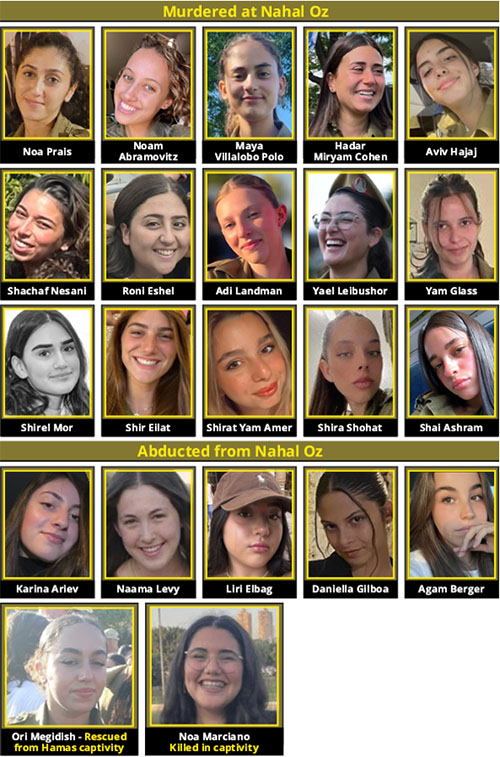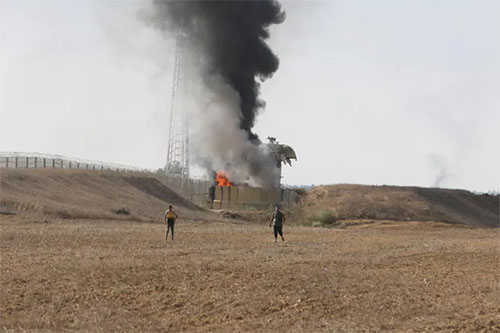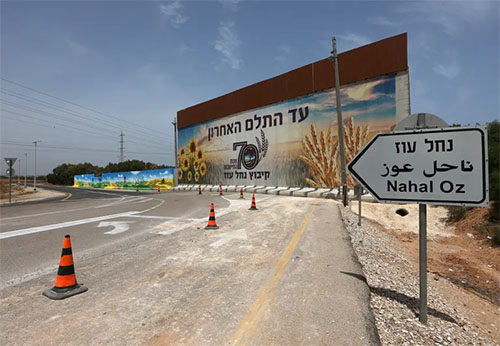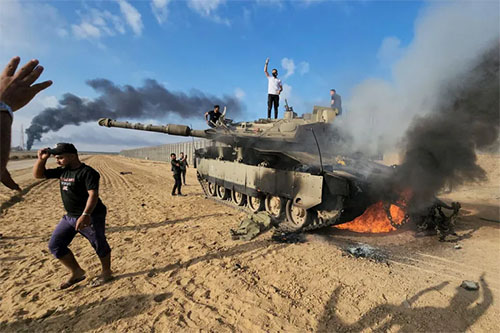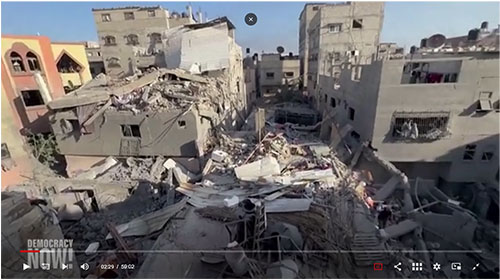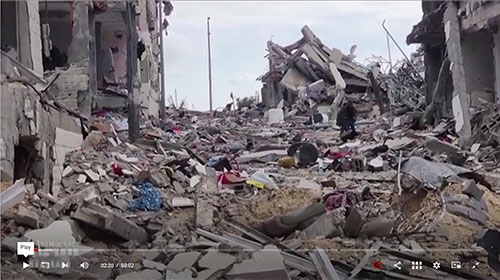by Ronen Bergman and Adam Goldman
Reporting from Tel Aviv
Published Nov. 30, 2023
Updated Dec. 2, 2023
NOTICE: THIS WORK MAY BE PROTECTED BY COPYRIGHT
YOU ARE REQUIRED TO READ THE COPYRIGHT NOTICE AT THIS LINK BEFORE YOU READ THE FOLLOWING WORK, THAT IS AVAILABLE SOLELY FOR PRIVATE STUDY, SCHOLARSHIP OR RESEARCH PURSUANT TO 17 U.S.C. SECTION 107 AND 108. IN THE EVENT THAT THE LIBRARY DETERMINES THAT UNLAWFUL COPYING OF THIS WORK HAS OCCURRED, THE LIBRARY HAS THE RIGHT TO BLOCK THE I.P. ADDRESS AT WHICH THE UNLAWFUL COPYING APPEARED TO HAVE OCCURRED. THANK YOU FOR RESPECTING THE RIGHTS OF COPYRIGHT OWNERS.
Israeli officials obtained Hamas’s battle plan for the Oct. 7 terrorist attack more than a year before it happened, documents, emails and interviews show. But Israeli military and intelligence officials dismissed the plan as aspirational, considering it too difficult for Hamas to carry out.
The approximately 40-page document, which the Israeli authorities code-named “Jericho Wall,” outlined, point by point, exactly the kind of devastating invasion that led to the deaths of about 1,200 people.
The translated document, which was reviewed by The New York Times, did not set a date for the attack, but described a methodical assault designed to overwhelm the fortifications around the Gaza Strip, take over Israeli cities and storm key military bases, including a division headquarters.
Hamas followed the blueprint with shocking precision. The document called for a barrage of rockets at the outset of the attack, drones to knock out the security cameras and automated machine guns along the border, and gunmen to pour into Israel en masse in paragliders, on motorcycles and on foot — all of which happened on Oct. 7.
The plan also included details about the location and size of Israeli military forces, communication hubs and other sensitive information, raising questions about how Hamas gathered its intelligence and whether there were leaks inside the Israeli security establishment.
THE MOSSAD'S FALSE FLAG AL QAEDA CELL
Rashid Abu Shbak, the head of Palestinian Preventive Security in the Gaza Strip said on Friday, December 6, 2002 that his forces had identified a number of Palestinian collaborators who had been ordered by Israeli security agencies to "work in the Gaza Strip under the name of Al-Qaeda." Al-Jazeera TV reported that the Palestinian authorities had arrested a group of Palestinian "collaborators with Israeli occupation" in Gaza, who were trying to set up an operation there in the name of bin Laden's Al-Qaeda. The Palestinian Authority spokesman said the members of the group had confessed that they were recruited and organized by the Israeli intelligence, Mossad. Sharon had personally claimed on December 4, 2002 that he had proof of Al-Qaeda operations in Gaza, and used the allegations to justify brutal Israeli Defense Forces attacks in the Gaza Strip the next day -- which was the start of the Islamic holiday, Eid, celebrating the end of Ramadan. Ten civilians were killed in the IDF assaults. Reuters published an extensive featured story on the affair by Diala Saadeh on December 7, 2002, under the headline "Palestinians: Israel Faked Gaza Al Qaeda Presence." The article quoted President Arafat, who told reporters at his West Bank Ramallah headquarters, "It is a big, big, big lie to cover [Sharon's] attacks and his crimes against our people everywhere." Information Minister Yasser Abed Rabbo explained: "There are certain elements who were instructed by the Mossad to form a cell under the name of Al Qaeda in the Gaza Strip in order to justify the assault and the military campaigns of the Israeli occupation army against Gaza." (Haaretz, Reuters and Al Jazeera, December 7, 2002) Sharon is of course a past master of false-flag tactics like these, having been implicated in the direction of the Abu Nidal organization and also in the setting up of Hamas.
On Sunday, December 8, 2002, Nabil Shaath, the Palestinian Authority Planning and International Cooperation Minister, held a press conference with Col. Rashid Abu Shbak, head of the PA 's Preventive Security Apparatus in the Gaza Strip, to release documents and provide further information about the Israeli intelligence creation of a self-styled Al Qaeda cell. Shaath called on the diplomats to "convey to their countries that they assume the responsibility of exerting pressure on the Israeli government to stop the Israeli aggression," and announced that the PA had handed ambassadors and consuls of the Arab and foreign countries documents revealing the involvement of the Israeli Intelligence in recruiting citizens from Gaza Strip in a fake organization carrying the name of Qaeda. The goal of the operation was to create a new pretext for aggression against the inhabitants of the Gaza Strip. Shbak said that the PA had found eight cases of fake Al Qaeda recruiting over the previous nine months. Three Palestinians were arrested, while another 11 Palestinians were released, "because they came and informed us of this Israeli plot." The PA Security Service had traced mobile phone calls and e-mails, purportedly from Germany and Lebanon, back to Israel; these were messages asking Palestinians to join Al Qaeda. One e-mail even bore the forged signature of Osama bin Laden. "We investigated the origin of those calls, which used roaming, and messages, and found out they all came from Israel," Shbak said. The recruits were paired with collaborators in Gaza, and received money and weapons, "although most of these weapons did not work." The money was provided by collaborators, or transferred from bank accounts in Israel and Jerusalem. (Palestine Ministry of Public Information, Islam Online, December 9, 2002)...
Palestine -- After Israeli had occupied the west bank of the Jordan River, the Gaza strip and the Sinai peninsula in June, 1967, the Israelis found themselves ruling over some two million Palestinians. Under the United Nations system it is illegal to annex territory acquired through armed conflict without the approval of the United Nations Security Council, which in this case was not forthcoming. Rather, the UNSC passed resolution 242, calling on Israel to withdraw to the internationally recognized borders as they had been before June 1967. (In the run-up to the Iraq war, Bush spokesmen accused Iraq of having violated some 17 United Nations Security Council resolutions; they conveniently forgot that Israel was the all-time champion in that department, since Israel is currently in violation of some 30 UNSC resolutions regarded the territories it has occupied since 1967. But the US never proposed war to enforce compliance with those resolutions.) The Israeli occupation of conquered Palestine was oppressive and humiliating, and a national resistance soon emerged in the form of the Palestinian Liberation Organization. Its leader was Yassir Arafat, a secular nationalist more or less in the Nasser mold. Since the PLO had few weapons, and since the Israeli army was a dominant presence, the PLO began doing what the Jews had done between 1945 and 1948 against the British occupation of the same territory: they launched guerilla warfare, which the occupiers quickly labeled terrorism. The official Israeli line was that there was no Palestinian people, but this was soon disproved. From the beginning, the Israeli Mossad was active in conducting provocations which it sought to attribute to the PLO and its peripheries: attacks on airliners and on the 1972 Olympic games in Munich are therefore of uncertain paternity. The more horrendous the atrocity, the greater the backlash of world public opinion against the PLO. There is no doubt that the Mossad controlled a part of the central committee of the organization known as Abu Nidal, after the nom de guerre of its leader, Sabri al Banna. In 1987-88, just as the first Palestinian intifada uprising was getting under way, there emerged in the occupied territories the organization known as Hamas. Hamas combined a strong commitment to neighborhood social services with the rejection of negotiations with Israel and the demand for a military solution which was sure to be labeled terrorism. Interestingly enough, one of the leading sponsors of Hamas was Ariel Sharon, a former general who was then a cabinet minister. These facts are widely recognized; US Ambassador to Israel Daniel Kurzer, an observant Jew, stated late in 2001 that Hamas had emerged "with the tacit support of Israel" because in the late 1980s "Israel perceived it would be better to have people turning toward religion, rather than toward a nationalistic cause." (Ha'aretz, Dec. 21, 2001) In an acrimonious Israeli cabinet debate around the same time, Israeli extremist Knesset member Silva Shalom stated:"between Hamas and Arafat, I prefer Hamas ... Arafat is a terrorist in a diplomat's suit, while the Hamas can be hit unmercifully." (Ha'aretz, Dec. 4, 2001)
This tirade provoked a walkout by Shimon Peres and the other Labor Party ministers. Arafat added his own view, which was that"Hamas is a creature of Israel which, at the time of Prime Minister Shamir, gave them money and more than 700 institutions, among them schools, universities, and mosques. Even [Israeli Prime Minister] Rabin ended up admitting it, when I charged him with it, in the presence of Mubarak." (Corriere della Sera, Dec. 11, 2001)
With incredible arrogance, the Bush administration has pronounced Arafat as unfit to be a negotiating partner. In effect, they are choosing Hamas -- or worse, an act of incalculable folly for Israel and for the United States as well.
-- 9/11 Synthetic Terror Made in USA, by Webster Griffin Tarpley
AMY GOODMAN: I wanted to ask you if you could talk about Israel’s involvement in Hamas gaining power. In 2009, Avner Cohen, a former Israeli religious affairs official who worked in Gaza for over 20 years, told The Wall Street Journal, quote, “Hamas, to my great regret, is Israel’s creation.” Another former Israeli official, Brigadier General Yitzhak Segev, said he was given a budget to help finance Islamist movements in Gaza to counter Yasser Arafat and his Fatah movement. Another former Israeli military official, David Hacham, said, quote, “When I look back at the chain of events, I think we made a mistake. But at the time, nobody thought about the possible results.” Your response, Tareq Baconi?
TAREQ BACONI: Well, the origins of that is really Hamas emerged as an offshoot of the Muslim Brotherhood chapter in the Gaza Strip. And the Muslim Brotherhood chapter was not a political party. It was a social party. And its operations in the Gaza Strip and throughout the Palestinian territories were actually granted licenses by Israeli occupying forces at the time, so there was a license for the Muslim Brotherhood chapter to operate openly in the Gaza Strip. When Hamas was established in 1987 and became a political party and a military party that was engaged in active resistance against Israel’s occupation, the policies within the Israeli government shifted, and obviously it became less open to allowing Hamas to function. However, that did not deter Israeli authorities from encouraging and promoting divide-and-rule tactics between the Islamist national movement, so Hamas, and secular nationalism around Fatah. And this has always been a tactic that the colonial forces have used globally, and obviously Israeli colonialism is no different. So it has directly and implicitly attempted divide-and-rule policies.
This really turned and came to a head in 2007, when Hamas, after winning democratic elections in 2006, rose to power, and the Israeli authorities, along with the U.S., attempted to initiate a regime change operation, which facilitated a civil war between Hamas and Fatah and allowed Hamas to take over the Gaza Strip. Since then, Israeli authorities have actively embraced the idea that Hamas would be accepted as a governing authority in the Gaza Strip. Now, part of the calculus in that is because of Gaza’s 2 million Palestinians. This is a demographic issue. Israel wanted to sever the Gaza Strip from the rest of historic Palestine in order to reinforce its claim that it’s a Jewish-majority state. By getting rid of 2 million Palestinians, two-thirds of whom are refugees demanding return, Israel can claim to be both a Jewish state and a democracy and restructure what is its apartheid regime. Now, in order to do that, it acquiesced to maintaining Hamas in governance, and it claimed that it placed a blockade around the Gaza Strip because Hamas was in power. And obviously this was bought in the international community, using what we were just talking about, the idea that Hamas is a terrorist organization, axis of evil, and, therefore, that this blockade makes sense.
What policymakers don’t understand is that Israel has engaged in blockades around the Gaza Strip and attempted to get rid of the population in the Gaza Strip long before Hamas was even established as a party. But with Hamas’s takeover of the Gaza Strip, this created a perfect fig leaf for Israel to maintain the Gaza Strip as a separate strip of land. And to do that, it had to acquiesce and, in some ways, even enable Hamas to maintain its position as a governing authority there. And this also further reinforced its efforts to try to maintain division among the Palestinian leadership and play divide-and-rule policies between the PA and Hamas.
-- “Divide and Rule”: How Israel Helped Start Hamas to Weaken Palestinian Hopes for Statehood, by Amy Goodman
The document circulated widely among Israeli military and intelligence leaders, but experts determined that an attack of that scale and ambition was beyond Hamas’s capabilities, according to documents and officials. It is unclear whether Prime Minister Benjamin Netanyahu or other top political leaders saw the document, as well.
Last year, shortly after the document was obtained, officials in the Israeli military’s Gaza division, which is responsible for defending the border with Gaza, said that Hamas’s intentions were unclear.
“It is not yet possible to determine whether the plan has been fully accepted and how it will be manifested,” read a military assessment reviewed by The Times.
Then, in July, just three months before the attacks, a veteran analyst with Unit 8200, Israel’s signals intelligence agency, warned that Hamas had conducted an intense, daylong training exercise that appeared similar to what was outlined in the blueprint.
But a colonel in the Gaza division brushed off her concerns, according to encrypted emails viewed by The Times.
“I utterly refute that the scenario is imaginary,” the analyst wrote in the email exchanges. The Hamas training exercise, she said, fully matched “the content of Jericho Wall.”
“It is a plan designed to start a war,” she added. “It’s not just a raid on a village.”
Officials privately concede that, had the military taken these warnings seriously and redirected significant reinforcements to the south, where Hamas attacked, Israel could have blunted the attacks or possibly even prevented them.
Instead, the Israeli military was unprepared as terrorists streamed out of the Gaza Strip. It was the deadliest day in Israel’s history.
Librarian's Comment: As reportage emerges revealing that Netanyahu's right wing cabal had developed a long-friendly financially supportive and militarily tolerant relationship with the Hamas forces that committed the massacre of Israelis, it's worth taking a look at who the primary victims were. I think it's a safe bet that the young people attending Supernova were not voting for Netanyahu, and clearly were not right-wing orthodox Jews with restricted diets and of course, a ban on secular dancing. This was probably the largest group of young, pro-peace Israelis that you could find in the entire country on that day. So, just assuming for the sake of engaging in reasonable speculation that Netanyahu wanted to give Hamas an opportunity to kill a large number of Israelis who he did not like anyway, the massacre of these youthful ravers may also be laid at his door. Clearly he deployed forces to protect the New York transplants known as "settlers" to allow them to continue their killing of Palestinian people, and their destructive revels in Palestinian border towns, while backed by IDF soldiers who made sure that Palestinians could not protect their property or themselves from these rampaging bands of renegade New Yorkers. That also meant that the soldiers were not there to guard against the incursion that made it so easy to roll in and kill hundreds of ravers, and made sure that military forces were deployed so far away that they couldn't prevent the catastrophe from unfolding in its full lurid horror. Finally, we now know that Netanyahu's cabal happily canoodling with Hamas in what it believed was a partnership to undermine the PLO, turned a blind eye to Hamas's military buildup and organization, allowing the well-planned, and apparently well-informed assault to take place.
LARA FRIEDMAN: Yeah. I mean, look, the taking of hostages, the taking of civilian hostages by Hamas — I mean, the October 7th attack was heinous in every aspect. The aspect of taking the hostages brought this home to Israelis in a way that is just — I don’t think anyone who has not spent time in a small country where everyone is — you know, there’s one degree of separation. This is incredibly real and incredibly personal for everyone in Israel.
What is notable is, in past experiences where there have been hostages taken, Israel has sort of turned over every rock possible, done everything possible to get them back. You have negotiations. You have contacts. You have — think of Gilad Shalit. I mean, the entire country mobilizes to get the hostage back — “hostage,” singular, “hostages,” plural. In this context, after October 7th, the issue of hostages is raised constantly by the Israeli government as a reason for why it has to do what it’s doing in Gaza, notwithstanding the fact that carpet bombing Gaza, using deep, deep penetrating bombs that are trying to get at the tunnels, seems like a very likely way to kill your own hostages. There has been a clear signal given — and if you listen to the — if you look at the Israeli media, the contacts that the families of hostages have had with the Netanyahu government, it is hard to avoid the conclusion that there isn’t actually a lot of desire on the part of the Israeli government to get the hostages back.
There have been numerous — and it’s been public — from other governments, from negotiators, there have been numerous offers by Hamas to exchange hostages, to release hostages in certain circumstances. There was, you know, a 24 — for a brief ceasefire. And so far, the argument seems to be, from the Israeli side, “We won’t do that, because anything we do would be a victory for Hamas. And that is — that we can’t let that happen, so releasing the hostages is simply not a priority.”
But talking about the hostages and accusing anyone who talks about ceasefire as not caring about the hostages is a wonderful tactic. All of us who are speaking out on this in social media, on media like this, are accused constantly of, “Well, you don’t care about the hostages.” The answer is, no, I care very much about the hostages. I don’t understand why the Israeli government doesn’t care more about the hostages. I would suggest that the Israeli government’s approach to the hostages makes clear that their objectives in this war are not about freeing the hostages. And that, I think, requires further thought.
-- Middle East Expert Lara Friedman: If Netanyahu Cared About Hostages, Why Did He Launch Ground Invasion?, by Amy Goodman
Israeli security officials have already acknowledged that they failed to protect the country, and the government is expected to assemble a commission to study the events leading up to the attacks. The Jericho Wall document lays bare a years-long cascade of missteps that culminated in what officials now regard as the worst Israeli intelligence failure since the surprise attack that led to the Arab-Israeli war of 1973.
[Michael Moore] As Bush sat in that Florida classroom, was he wondering if maybe he should have shown up to work more often? Should he have held at least one meeting since taking office to discuss the threat of terrorism with his head of counterterrorism? Or maybe Mr. Bush wondered why he had cut terrorism funding from the FBI. Or perhaps he just should have read the security briefing that was given to him on August 6th, 2001, which said that Osama bin Laden was planning to attack America by hijacking airplanes. But maybe he wasn't worried about the terrorist threat, because the title of the report was too vague.
[Condoleezza Rice, National Security Advisor] I believe the title was, "Bin Laden Determined to Attack Inside the United States."
-- Fahrenheit 9/11, written, directed and produced by Michael Moore
Underpinning all these failures was a single, fatally inaccurate belief that Hamas lacked the capability to attack and would not dare to do so. That belief was so ingrained in the Israeli government, officials said, that they disregarded growing evidence to the contrary.
The Israeli military and the Israeli Security Agency, which is in charge of counterterrorism in Gaza, declined to comment.
Officials would not say how they obtained the Jericho Wall document, but it was among several versions of attack plans collected over the years. A 2016 Defense Ministry memorandum viewed by The Times, for example, says, “Hamas intends to move the next confrontation into Israeli territory.”
Such an attack would most likely involve hostage-taking and “occupying an Israeli community (and perhaps even a number of communities),” the memo reads.
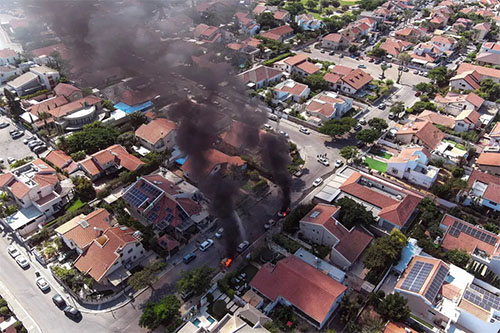
Vehicles caught fire in Ashkelon, Israel, as rockets were launched from the Gaza Strip on Oct. 7.Credit...Ilan Rosenberg/Reuters
The Jericho Wall document, named for the ancient fortifications in the modern-day West Bank, was even more explicit. It detailed rocket attacks to distract Israeli soldiers and send them hurrying into bunkers, and drones to disable the elaborate security measures along the border fence separating Israel and Gaza.
Hamas fighters would then break through 60 points in the wall, storming across the border into Israel. The document begins with a quote from the Quran: “Surprise them through the gate. If you do, you will certainly prevail.”
The same phrase has been widely used by Hamas in its videos and statements since Oct. 7.
One of the most important objectives outlined in the document was to overrun the Israeli military base in Re’im, which is home to the Gaza division responsible for protecting the region. Other bases that fell under the division’s command were also listed.
Hamas carried out that objective on Oct. 7, rampaging through Re’im and overrunning parts of the base.
The audacity of the blueprint, officials said, made it easy to underestimate. All militaries write plans that they never use, and Israeli officials assessed that, even if Hamas invaded, it might muster a force of a few dozen, not the hundreds who ultimately attacked.
Israel had also misread Hamas’s actions. The group had negotiated for permits to allow Palestinians to work in Israel, which Israeli officials took as a sign that Hamas was not looking for a war.
For years, the various governments led by Benjamin Netanyahu took an approach that divided power between the Gaza Strip and the West Bank — bringing Palestinian Authority President Mahmoud Abbas to his knees while making moves that propped up the Hamas terror group.
The idea was to prevent Abbas — or anyone else in the Palestinian Authority’s West Bank government — from advancing toward the establishment of a Palestinian state.
Thus, amid this bid to impair Abbas, Hamas was upgraded from a mere terror group to an organization with which Israel held indirect negotiations via Egypt, and one that was allowed to receive infusions of cash from abroad.
Hamas was also included in discussions about increasing the number of work permits Israel granted to Gazan laborers, which kept money flowing into Gaza, meaning food for families and the ability to purchase basic products.
Israeli officials said these permits, which allow Gazan laborers to earn higher salaries than they would in the enclave, were a powerful tool to help preserve calm.
Toward the end of Netanyahu’s fifth government in 2021, approximately 2,000-3,000 work permits were issued to Gazans. This number climbed to 5,000 and, during the Bennett-Lapid government, rose sharply to 10,000.
Since Netanyahu returned to power in January 2023, the number of work permits has soared to nearly 20,000.
-- For years, Netanyahu propped up Hamas. Now it’s blown up in our faces. The premier’s policy of treating the terror group as a partner, at the expense of Abbas and Palestinian statehood, has resulted in wounds that will take Israel years to heal from, by Tal Schneider, Times of Israel, 8 October 2023
But Hamas had been drafting attack plans for many years, and Israeli officials had gotten hold of previous iterations of them. What could have been an intelligence coup turned into one of the worst miscalculations in Israel’s 75-year history.
In September 2016, the defense minister’s office compiled a top-secret memorandum based on a much earlier iteration of a Hamas attack plan. The memorandum, which was signed by the defense minister at the time, Avigdor Lieberman, said that an invasion and hostage-taking would “lead to severe damage to the consciousness and morale of the citizens of Israel.”
The memo, which was viewed by The Times, said that Hamas had purchased sophisticated weapons, GPS jammers and drones. It also said that Hamas had increased its fighting force to 27,000 people — having added 6,000 to its ranks in a two-year period. Hamas had hoped to reach 40,000 by 2020, the memo determined.
Last year, after Israel obtained the Jericho Wall document, the military’s Gaza division drafted its own intelligence assessment of this latest invasion plan.
Hamas had “decided to plan a new raid, unprecedented in its scope,” analysts wrote in the assessment reviewed by The Times. It said that Hamas intended to carry out a deception operation followed by a “large-scale maneuver” with the aim of overwhelming the division.
But the Gaza division referred to the plan as a “compass.” In other words, the division determined that Hamas knew where it wanted to go but had not arrived there yet.
On July 6, 2023, the veteran Unit 8200 analyst wrote to a group of other intelligence experts that dozens of Hamas commandos had recently conducted training exercises, with senior Hamas commanders observing.
The training included a dry run of shooting down Israeli aircraft and taking over a kibbutz and a military training base, killing all the cadets. During the exercise, Hamas fighters used the same phrase from the Quran that appeared at the top of the Jericho Wall attack plan, she wrote in the email exchanges viewed by The Times.
The analyst warned that the drill closely followed the Jericho Wall plan, and that Hamas was building the capacity to carry it out.
The colonel in the Gaza division applauded the analysis but said the exercise was part of a “totally imaginative” scenario, not an indication of Hamas’s ability to pull it off.
“In short, let’s wait patiently,” the colonel wrote.
The back-and-forth continued, with some colleagues supporting the analyst’s original conclusion. Soon, she invoked the lessons of the 1973 war, in which Syrian and Egyptian armies overran Israeli defenses. Israeli forces regrouped and repelled the invasion, but the intelligence failure has long served as a lesson for Israeli security officials.
“We already underwent a similar experience 50 years ago on the southern front in connection with a scenario that seemed imaginary, and history may repeat itself if we are not careful,” the analyst wrote to her colleagues.
While ominous, none of the emails predicted that war was imminent.
"We did not have…threat information that was in any way specific enough to suggest something was coming in the United States." -- Condoleezza Rice, National Security Advisor [responding to Gorelick]
"Nobody in our government, at least, and I don't think the prior government, could envision flying airplanes into buildings on such a massive scale." -- George Bush, Jr.
-- The 9/11 Commission Report, by The National Commission on Terrorist Attacks Upon the United States
"This is our 9/11.” -- Michael Herzog, Israeli ambassador to the United States
"In a way, this is our 9/11" -- IDF International Spokesperson Lt. Col. Richard Hecht, 10/8/23
Nor did the analyst challenge the conventional wisdom among Israeli intelligence officials that Yahya Sinwar, the leader of Hamas, was not interested in war with Israel. But she correctly assessed that Hamas’s capabilities had drastically improved. The gap between the possible and the aspirational had narrowed significantly.
The failures to connect the dots echoed another analytical failure more than two decades ago, when the American authorities also had multiple indications that the terrorist group Al Qaeda was preparing an assault. The Sept. 11, 2001, attacks on the World Trade Center and the Pentagon were largely a failure of analysis and imagination, a government commission concluded.
But on that September day we were unprepared. We did not grasp the magnitude of a threat that had been gathering over time. As we detail in our report, this was a failure of policy, management, capability, and -- above all -- a failure of imagination.
-- The 9/11 Commission Report, by The National Commission on Terrorist Attacks Upon the United States
The analyst warned that the drill closely followed the Jericho Wall plan, and that Hamas was building the capacity to carry it out.
The colonel in the Gaza division applauded the analysis but said the exercise was part of a “totally imaginative” scenario, not an indication of Hamas’s ability to pull it off.
“The Israeli intelligence failure on Oct. 7 is sounding more and more like our 9/11,” said Ted Singer, a recently retired senior C.I.A. official who worked extensively in the Middle East. “The failure will be a gap in analysis to paint a convincing picture to military and political leadership that Hamas had the intention to launch the attack when it did.”
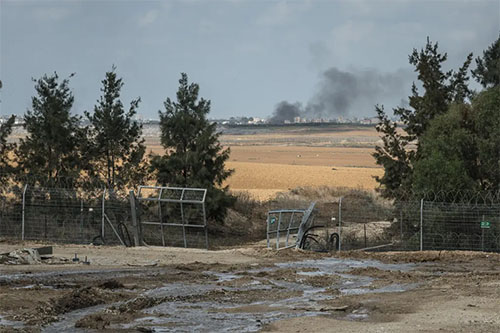
The breached security fence in the village of Kfar Azza, Israel, three days after it was attacked by Hamas.Credit...Sergey Ponomarev for The New York Times
Ronen Bergman is a staff writer for The New York Times Magazine, based in Tel Aviv. His latest book is “Rise and Kill First: The Secret History of Israel’s Targeted Assassinations,” published by Random House. More about Ronen Bergman
Adam Goldman writes about the F.B.I. and national security. He has been a journalist for more than two decades. More about Adam Goldman

